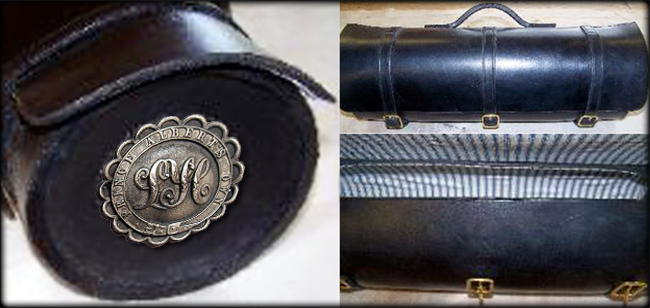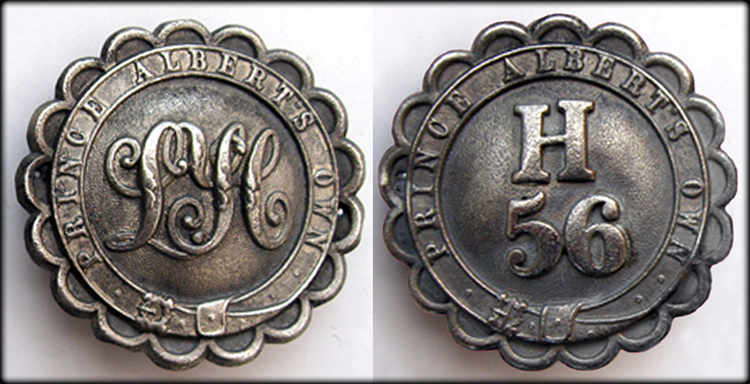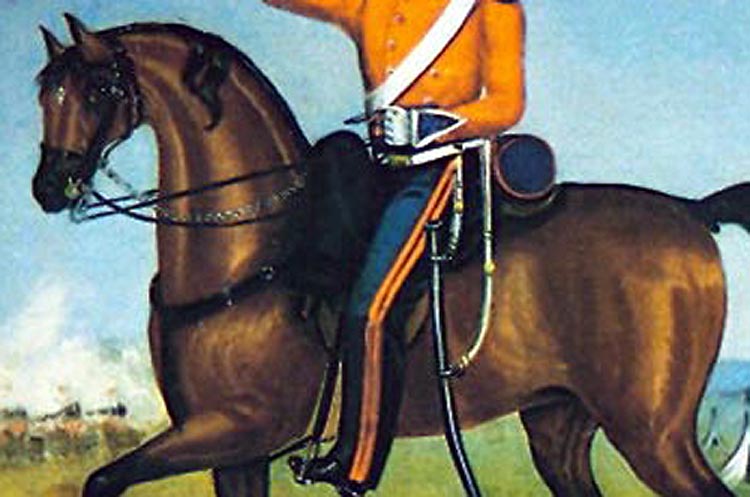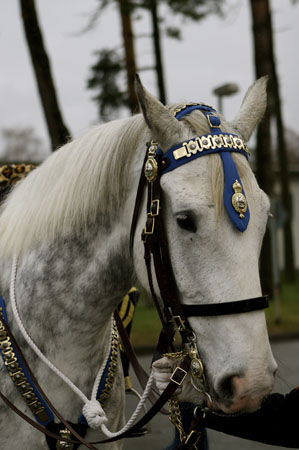
These badges are paired, one with "LYC" and one with the
Troop letter and number allocated to the individual Yeoman.
Each badge would fit either end of the valise bag just
behind the saddle. How long this practise lasted for is
unknown but its more than likely that by the end of the
1880s they were no longer used. The badges are white metal
and have individual letter and numbers fixed to the basic
plate by wire prongs. The "LYC" badge is all in one and most
likely worn on the off side of the saddle valise bag.
(Many thanks to Steven Bosley,
http://www.bosleys.co.uk)

Above is a representation of a c1850 pattern Cavalry valise
with the superimposed image of the "LYC" valise badge placed
in its position, obviously the numbered badge would be at
the other end. The QM would have these bags stacked up in
the stores with the numbered end facing him and he would
simply collect the Troop allocated numbered bag (containing
his effects) for the individual Yeoman on request.


 The
painting may be viewed at Leicester Museums & Galleries
collections,
The
painting may be viewed at Leicester Museums & Galleries
collections,
New Walk Museum, 53 New Walk
Leicester
Leicestershire Yeomanry Quarter Master in 1841. As you can
see from the painting, all the leather is black apart from
the saddle. The shabraque is a black lambskin or sheepskin
covering the saddle bags (front) and over the saddle then
tucked under the rear saddle role. The surcingle is yellow
and red striped in the same way that the waist belt of the
uniform is striped, its not clear in these pictures but
viewing the painting confirms this. There is no badge on the
breastplate and a crupper is worn. The bit is standard for
the period and there appears to be no other ornaments on the
bridle.


A decorated bridle head band, black sheep skin seat cover
with what appears to be an ornamented Shabraque.
Horses and Saddlery
Published 1965 by J A Allen & Company
Major G Tylden
The Yeomanry
Pages 162-3
As every formation of Yeomanry, whatever the strength might
be, was to all intents and purposes a law unto itself as to
what uniform and equipment was to be used, it is not easy to
say what Saddlery any one unit had. By the end of the
nineteenth century U.P. Saddles were drawn from Ordnance,
the type varying with state of the saddles in store. The
annual camp, not always held, and few days drill in the year
did not lead to undue wear and tear, so Saddlery would last
a Yeomanry unit considerably longer than the Regular one.
There is extant a list of 24 units in existence in 1850 who
made returns of Saddlery in use. certainly up to about 1890,
and in some cases later, many men rode their hunting
saddles, called "Plain Saddles", irrespective of the type
selected by their unit.
In 1850 the Derbyshire and West Somerset units had these
saddles, presumably used by all ranks. In many cases the
officers had different saddles to the men.
Three units, Ayrshire, Cambridgeshire and Cheshire, had
Heavy Dragoon patterns, as had the Long Melford Lancers of
Suffolk. The Ayrshire men had the old pattern, probably that
of 1796.
The Light Cavalry patterns were popular and were called
"Hussar", "Light Dragoon", or "Cossack" saddles. As one
regiment , the 1st West Yorkshire, had "the old Light
Dragoon saddle", the three names presumably refer to the
post 1816 loose
pilch seat Hussar pattern, as used
by Regular Light cavalry to 1855. The Staffordshire unit had
black saddles for the officers and brown for the men.
The North Devon has saddles as for the 14th Light Dragoons,
but with panels instaed of blankets, and an illustration
shows the Royal 1st Devon in 1840 with an officer using an
Hussar saddle with a lambskin and no shabraque. After 1855
the U.P. wood arch saddle was used when available. Thus the
Gloucestershire Hussars were issued with 200 in 1881 and in
1885 the Berkshire regiment had round cantle saddles,
possibly an experimental issue of the 1844 pattern, which
had been on trial for some time.
Faced with the problem of providing some 10,000 sets of
Saddlery for the Imperial Yeomanry companies raised in 1899
for the South African War, the civilian Committee, which was
responsible for all equipment and uniforms, nut not arms,
had to take what ever was available. There was an attempt to
get saddles made by the firms who supplied civilian types,
but this proved impossible; for one thing the price would
have prohibitive, and the result was that any types
available were got together and issued. these varied from
the U.P. wood arch saddle to the Colonial type, and included
R.A. drivers' saddles, known as "Artillery" saddles and
liked. By 1901 many of the units had the Colonial saddle,
which stoop up well to the rough work and, as by this time
as little as possible was carried on the saddle, they proved
amply strong enough. With a big surplus of these saddles on
hand they were issued to the Imperial Yeomanry in great
Britain in 1902, the manufacturers making a slightly lighter
pattern for other ranks than the officers' pattern. By 1916
the Yeomanry, no longer "Imperial", but part of the
Territorial Force, were receiving the U.P. steel arch
saddle.

Here is an officers charger of The Queen's Royal Hussars on
parade in full review kit in 2007.